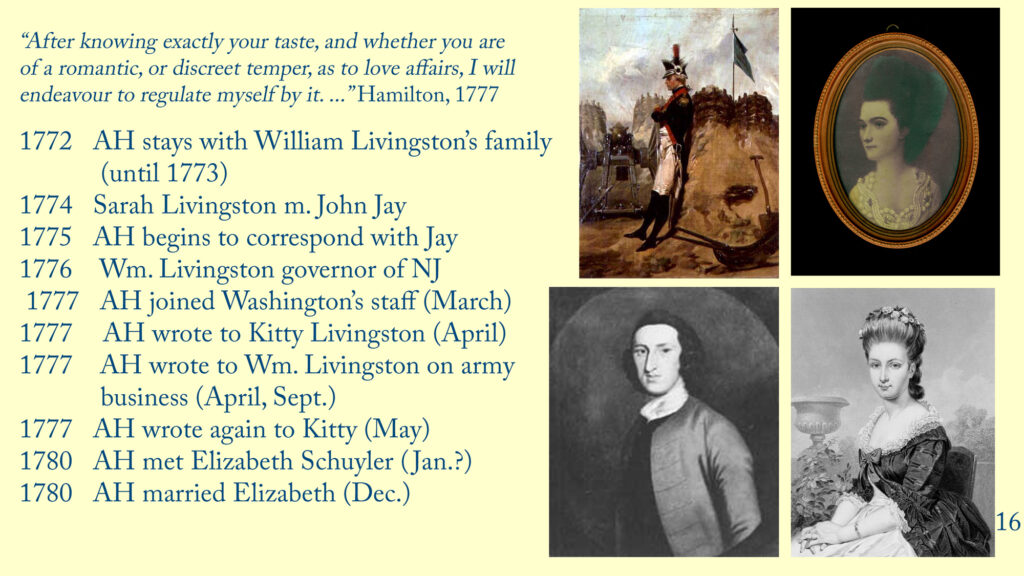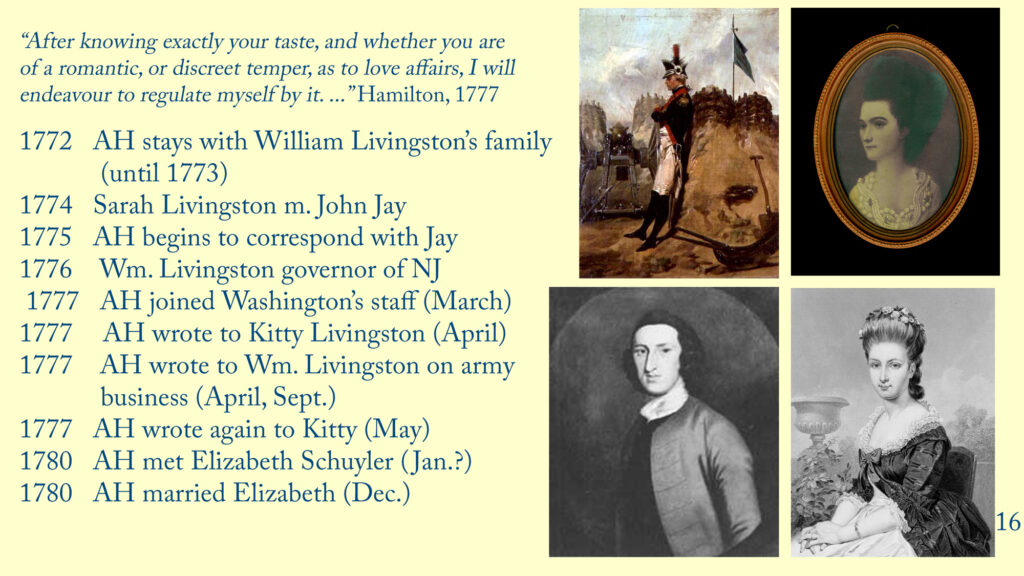This series of posts is available as a video playlist at https://youtube.com/playlist?list=PL9eyRnt5W114bs8_CJNvlcLfIB4NW_YTB.
Last week we looked at primary sources to see whether an affair between Alexander Hamilton and Angelica Schuyler Church was certain (no) or probable (also no). Next question: is it possible, which means there is some evidence in favor, and nothing that flat-out contradicts it?
If Alexander made a habit of sleeping with other women, it wouldn’t be a stretch to say that perhaps he slept with Angelica, too. The Reynolds Affair is the obvious example of him sleeping with someone other than his wife, but that seems to have been a matter of him being targeted for blackmail. For more on that see last week’s post, and Alexander Hamilton and the Reynolds Affair.
This week: a sizzling letter that many interpret as showing Alexander’s wild lust for women. (Sorry the footnote links don’t seem to be working, but the notes do appear at the end of the post.)
Re the possibility of an affair: the “goddess letter”
Is there other evidence of a pattern of promiscuous behavior by Alexander Hamilton?
More than 7,000 letters written by Hamilton survive.[1] About a hundred of those are from Alexander to his wife, Eliza. Most include expressions of his love for her. Of the thousands of other letters, only two deal with romance.
Both were written to the same woman.[2] Both are from 1777, when Hamilton was a soldier in the Revolutionary War, on General Washington’s staff. Here’s an excerpt from one of them:
After knowing exactly your taste, and whether you are of a romantic, or discreet temper, as to love affairs, I will endeavour to regulate myself by it. If you would choose to be a goddess, and to be worshipped as such, I will torture my imagination for the best arguments the nature of the case will admit, to prove you so. You shall be one of the graces, or Diana, or Venus, or something surpassing them all. And after your deification, I will cull out of every poet of my acquaintance, the choicest delicacies they possess, as offerings at your Goddesships’ shrine.[3]
Well, that sounds like a love affair, doesn’t it? It even mentions love affairs! Some scholars consider this proof that during his military service, at least, Hamilton is “girl crazy” and intent on getting this woman into his bed.
But there are two points worth noting about the “goddess letter”. One has to do with the writing style, the other with the recipient.
Re the style: let’s compare a letter of 1778 – that’s a year after Alexander’s letter. This one was written by Major-General Benedict Arnold. He’s proposing marriage to Peggy Shippen.
Pardon me, Dear Madam, for disclosing a passion I could no longer confine in my tortured bosom. I have presumed to write to your Papa, and have requested his sanction to my addresses. … Consider before you doom me to misery, which I have not deserved but by loving you too extravagantly. … Whatever my fate may be, my most ardent wish is for your happiness and my latest breath will be to implore the blessing of heaven on the idol and only wish of my soul.[4]
To us, this sort of writing sounds odd … but fashions change. Personally, I suspect (I hope!) that in 200 years, George Michael’s expression of romantic interest is going to sound far more peculiar than Benedict Arnold’s: “I want your sex, I want your love, I want your sex, I want your sex.”[5]
In the eighteenth century, it was normal for men to use flowery language when speaking romantically to women of their own class. Alexander’s letter should be read as a romantic flirtation, not an aggressive attempt to get the recipient to have sex.
Moving on to the second point: the recipient of the “goddess letter”. It was written by Hamilton on April 11, 1777, to 26-year-old Catherine (“Kitty”) Livingston, daughter of William Livingston.[6] Michael Newton notes that in 1772-1773, when Hamilton arrived in America, he stayed with William Livingston’s family.[7] Livingston’s daughter Sara married John Jay in 1774; Hamilton began corresponding with Jay in 1775. Jay and Hamilton eventually collaborated on the Federalist Papers. William Livingston became governor of New Jersey in 1776. When Hamilton joined Washington’s staff in March 1777, he corresponded officially with Livingston several times.
William Livingston’s daughter Susanna asked Hamilton to write to her sister Kitty. According to Hamilton’s recap in the letter we’re looking at, Susanna told him that Kitty has a “relish for politics”, and Susanna thinks Hamilton’s position on Washington’s staff makes him a suitable “political correspondent”[8]. Well, that doesn’t sound very romantic, does it?
The point here is: Hamilton knows Kitty’s father, sisters, and in-laws – the whole family. After the “goddess” section quoted above, the last two (of a total of five) paragraphs in the letter are a report on the American army’s situation and on the prospects for military action by the British. He’d have expected Kitty to share that letter, for its news. The idea that he would blatantly attempt to seduce Kitty in a letter that would be read by the whole family … that’s ludicrous.

The second letter to Kitty, a few months later, has much the same tone. It starts light and flirtatious, and also ends with military and political news.[9]
I’ve spent time discussing these two letters to Kitty from 1777 because they are the only romantic letters we have that aren’t addressed to Eliza. And they don’t work as evidence for Alexander showing a pattern of promiscuity – chasing women, or having one-night stands or flings.
Incidentally, Catherine Livingston and Eliza Schuyler were good friends. In early 1780, soon after he met Eliza, Alexander sent a letter addressed to both of them, with the same sort of flirtatious rhetoric that he used in the “goddess letter” in 1777.[10]
Col Hamiltons compliments to Miss Livingston and Miss Schuyler. He is sorry to inform them that his zeal for their service make him forget that he is so bad a Charioteer as hardly to dare to trust himself with so precious a charge; though if he were only to consult his own wishes like Phaeton he would assemble the chariot of the sun, if he were sure of experiencing the same fate. ….
Next week: But what about that tomcat story?
[1] Hamilton’s letters, as well as letters by most of the other Founding Fathers, are available on Founders Online – an invaluable resource for all scholars of early United States history. https://www.founders.archives.gov/
[2] These two letters are discussed in Michael Newton, “Was Alexander Hamilton ‘girl crazy and brimming with libido’? Hamilton’s letter to Catharine ‘Kitty’ Livingston,” Discovering Hamilton, p. 234. https://discoveringhamilton.com/alexander-hamilton-kitty-livingston-april-1777-letter/
[3] April 11, 1777: https://founders.archives.gov/documents/Hamilton/01-01-02-0128 Follow-up of May 1777: https://founders.archives.gov/documents/Hamilton/01-01-02-0170
[4] Benedict Arnold’s proposal to Petty Shippen, 9/25/1778. From Stedman & Hutchinson, comps., A Library of American Literature: An Anthology in Eleven Volumes, 1891. Vol. 3: Literature of the Revolutionary Period, 1765-1787. https://www.bartleby.com/400/prose/502.html
[5] George Michael, “I Want Your Sex,” 1987
https://genius.com/George-michael-i-want-your-sex-lyrics
[6] Hamilton’s age has long been a matter of dispute. Based on recently discovered legal documents, Michael Newton argues persuasively that Hamilton was born between February 23 and August 5, 1754. (See “Alexander Hamilton’s Birth, Early Biography, and More: Newly Discovered Legal Testimony from Alexander Hamilton, His Aunt, and Others,” Discovering Hamilton, p. 4; and video of a 2019 lecture on this topic at https://discoveringhamilton.com/hamilton-birthdate-lecture-july-10-2019/ .) If Hamilton was born in 1754, then when he wrote the “goddess letter” on April 11, 1777, he would have been 22 or 23 years old.
[7] On Hamilton’s stay in New Jersey in 1772-1773, see Michael Newton’s research: https://discoveringhamilton.com/alexander-hamilton-lived-grammar-school-elizabethtown-new-jersey/
[8] Hamilton to Catherine Livingston, 4/11/1777: “I take pleasure in transmitting you a letter, committed to my care, by your Sister Miss Suky, and in executing a promise, I gave her, of making an advance towards a correspondence with you. She says you discover, in all your letters to her, a relish for politics, which she thinks my situation qualifies me better for gratifying, than would be in her power; and from a desire to accommodate you in this particular, as well as to get rid of what she calls a difficult task to herself, and to give me an opportunity of enjoying the felicity which must naturally attend it, she wishes me to engage on the footing of a political correspondent.” https://founders.archives.gov/documents/Hamilton/01-01-02-0128
[9] Hamilton to Catherine Livingston, May 1777 https://founders.archives.gov/documents/Hamilton/01-01-02-0170
[10] To Catherine and Eliza in January or February 1780 https://founders.archives.gov/documents/Hamilton/01-02-02-0587
More
- This series of posts is an elaboration of a six-page appendix on this subject that appears in Alexander Hamilton and the Reynolds Affair.
- For my books on Alexander Hamilton, see this page; for blog posts, see the Hamilton tag.
- Want wonderful art delivered weekly to your inbox? Check out my Sunday Recommendations list and rewards for recurring support: details here. For examples of favorite recommendations from past years, click here.
